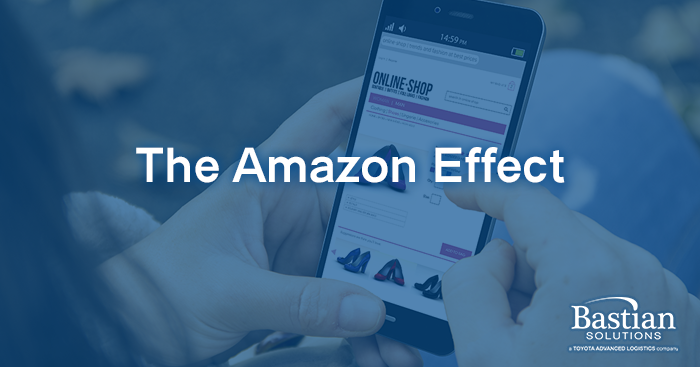
Lessons From the Amazon Effect
John Knudsen | 19 December 2018
The Amazon Effect is the impact that Amazon has had within the retail world, beginning with the service Amazon offers to its customers and ending with the impact to its competition. We see how it continues to change shopping malls and retail stores. We also notice the impact to our neighborhoods, with daily visits from a host of carriers. But how does it impact us in the material handling industry and the way we address supply chain challenges?
The Early Days of Amazon and E-Commerce Fulfillment
Amazon impacted the marketplace with its strong focus on e-tail marketing and sales. At the turn of the millennia, e-commerce was growing fast. But the strong link to brick-and-mortar retail remained and was assumed essential for success. Retailers continued to focus on classic store distribution. E-commerce fulfillment operations were added on the side to handle the smaller volumes that represented the online order business. Wholly digital retailers found success to be hard fought, typically requiring niches to gain enough volume to stay in business. Many digital retailers leaned on third-party operators to run their fulfillment services. These third-party operations employed simple fulfillment processes, lacking the detailed attention to service that larger retailers could offer.
Then everything changed. Amazon grew its brand and collaborated with niche e-tailers, cornering e-commerce fulfillment solutions. Ordering was made easy, customer service was good, and delivery was quick. This won new business in droves, setting classic retailers up for a challenge. It has made the smaller retailers and e-tailers wonder how to react or whether they should continue operating as they had been. Those third-party operators, who at times covet Amazon’s business, are trying desperately to show that they offer the same competitive services. And now those competing retailers face a foe that does not rely on product sales solely to drive profitability.
Finding Ways to Counter the Amazon Effect
So, what are the nimble retailers and third-party providers doing? They are realizing that the customer experience is paramount to winning and keeping business. It’s driving retailers, e-tailers and third-party operators alike to pursue better order fulfillment solutions. As retailers shift to experience-based brick-and-mortar solutions, the pressure to ‘distribute’ product has changed to smaller, more focused volumes. The ability to handle order fulfillment is now pushing forward as a service that needs to have increased priority and quality.
The delivery itself is a single source of competitive advantage that makes or breaks the customer relationship. Amazon’s offerings include delivery Service Level Agreements (SLAs) that are at or near the best in the e-commerce retail arena. Relationships with carriers and understanding available service levels are critical for competition because the shipment’s origin location may drive the delivery service level that a company can expect. Offering competitive service to the end customer could be as easy as inviting carriers in for pick-up or be completely unavailable, based simply on location. Studying available service levels and finding options is critical if the operation’s location will be competitive. Also, understanding which alternatives are available to determine optimal operating location will allow a business to understand what it faces.
The result of this speed-of-delivery pressure is the advent of omni-channel fulfillment centers across multiple metro locations for larger retailers and third-party operators. These centers provide strategic proximity to the customer-base, enabling competitive delivery. They can also work with store sites to support buy-online, pick-up-in-store and return-in-store services.
The Amazon Effect has also created a new market in the carrier business. Loads are smaller and greater in frequency. The large parcel carriers are increasingly finding competition for their routes. Bulk requirements are shifting with brick-and-mortar store changes by retailers. Lastly, operations are increasingly driven to locations that support transportation solutions to service the entire country more efficiently.
Material Handling Solutions for E-Commerce and Omni-Channel Fulfillment
From the material handling standpoint, retailers and third-party operators are making changes there too. First, retailers are employing strategies to address the shift in product volumes. Order sizes have decreased, and destination count has exploded. The omni-channel order fulfillment approach must effectively handle orders based on the destination and customer. Priority for meeting delivery SLAs is now part of task completion. For internal customers (stores), the retailer must find a delivery method that effectively aids stocking or storage in-store for smaller volumes.
External customers need to be delighted with the delivery. Handling methods are being coupled with technology to enhance quality. This includes managing things like order accuracy and packing instructions that will help drive customer satisfaction. Including information that improves delivery accuracy and supports the ‘not-so-accurate’ delivery is a must, such as detailed order information and easy methods to return unwanted items.
The resulting effects of these pressures have moved the industry toward equipment and designs that service more finite handling with distribution/fulfillment centers. These include the introduction of new picking solutions (like Perfect Pick and AutoStore) and robotics. WMS solutions have become more varied and customizable. Solutions are utilizing more technologically advanced methods to control and complete their processes, including sophisticated Warehouse Execution Systems (WES).
The next ‘Amazon’ is out there. The Amazon Effect teaches us that closing the gap between you and the customer is always the best way to stay ahead of the Amazon’s.
John Knudsen is a Senior Consulting Engineer in Bastian’s Consulting department. He has more than 20 years of experience in distribution and fulfillment design and process improvement.
Comments
No comments have been posted to this Blog Post
Leave a Reply
Your email address will not be published.
Comment
Thank you for your comment.